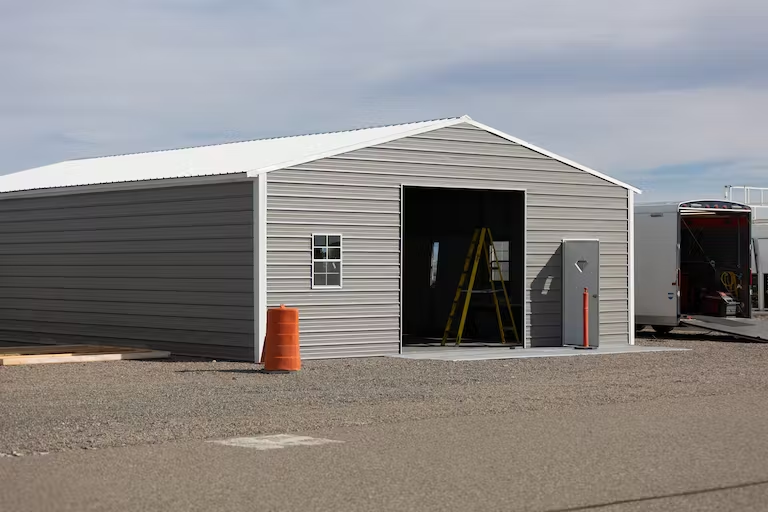Reviewed by Mila PereraSep 20 2022
Aviation has been a nuts-and-bolts effort since the Wright brothers pioneered it in the back of their bicycle store in Dayton, Ohio.
 The new UAS trailer and workspace. Image Credit: Idaho National Laboratory.
The new UAS trailer and workspace. Image Credit: Idaho National Laboratory.
Regardless of all of the sophisticated technology at Idaho National Laboratory's disposal for testing high-tech cameras, radios, and sensors, there is still a lot of gearhead ingenuity involved.
A $500,000 high-tech surveillance camera is kept aloft on an airplane powered by a Honda pressure washer’s 1/2-horsepower gasoline motor. The plane’s launch catapult is essentially an enlarged potato cannon.
The organization works from a base comprising a 1,000 foot paved runway, a control trailer, and a newly built 1,500 square-foot hangar in both Idaho Falls and at the INL Site.
“Workhorses”
INL’s capability in testing unmanned aerial vehicles, or UAVs (better known as drones), has been recognized by the Department of Energy complex.
Over the past two decades, the facility has established capabilities for testing novel platforms and evaluating technologies for DOE, the Department of Defense, and private industry.
The INL Site has shown to be an excellent location for testing unmanned aerial vehicles against real-world conditions.
These conditions include severe weather, temperature swings, and day/night operations, with 890 square miles of open high-altitude desert, a secure border, and a robust wireless test bed.
The initial UAV work at INL involved infrared imagery and sensors to observe remediation work and to gather GPS information in the case of wildfires to coordinate ground efforts. The runway, installed in 2010, enabled the use of fixed-wing aircraft.
INL has invested more than $4 million to train staff, acquire planes, and create support facilities.
INL supports over 40 different types of unmanned aircraft with mobile control stations that include power, communication, monitoring, and data gathering capabilities.
The INL fleet’s flagship is a modified Arcturus T-20, a medium-range, completely composite aircraft.
It measures 8 feet long and 18 feet broad from wingtip to wingtip, weighs 175 pounds when fully fueled, and can fly for 10 to 12 hours.
They’re workhorses. They’re mules. They’re anything we want them to be.
Matthew Balderree, Idaho National Laboratory
Matthew Balderree came to INL in 2014 from the US Air Force.
Managing a Fleet
Once a drone is in the air, one of the most challenging tasks is not flying it from the command trailer but monitoring the computer to ensure that nothing goes wrong.
More and more, our job is making sure it’s doing what needs to be done as opposed to telling it what to do.
Matthew Balderree, Idaho National Laboratory
A system equipped with artificial intelligence (AI) should be capable of inspecting a complex of wind turbines or a solar farm and autonomously downlink data to computers on the ground for processing if properly equipped and designed.
It can help nuclear and other industrial plants operate more effectively by lowering inspection expenses. Similarly, AI might improve agricultural efficiency by examining sprinkler systems automatically or looking for insect damage to crops.
“Drones are going to have a really good return on investment when it gets to that point,” Balderree states. The INL also utilizes drones for nuclear and other industrial plant operations.
INL provides innovative sensor, electronics, and communication package engineering and integration services. The team can design, build, and integrate custom boards, chipsets, and electronics.
They work throughout nearly the entire radio frequency spectrum, which is managed and administered by INL’s Wireless Test Bed and its frequency spectrum managers.
INL has received several Certificates of Waiver or Authorization from the Federal Aviation Administration.
These certificates, issued to public operators for specified unmanned aerial activities, permit the laboratory to function in the administration’s permitted airspace, which stretches from Mud Lake northeast of the INL Site to Carey, ID, in the southwest.
This makes it easy to conduct a variety of tests in one location.
“We’re probably one of the few locations with that quality of assets,” says Balderree.
One of the most rewarding aspects of Balderree’s job is the crew’s ability to autonomously conduct rapid prototyping of radios and sensors.
We don’t have a dog in the fight. We’re trying to find out if these products are going to meet the needs of the guys in the field. We want to know that a piece of equipment is going to power up and work every time. We provide integration, testing and validation from an unbiased partner.
Matthew Balderree, Idaho National Laboratory